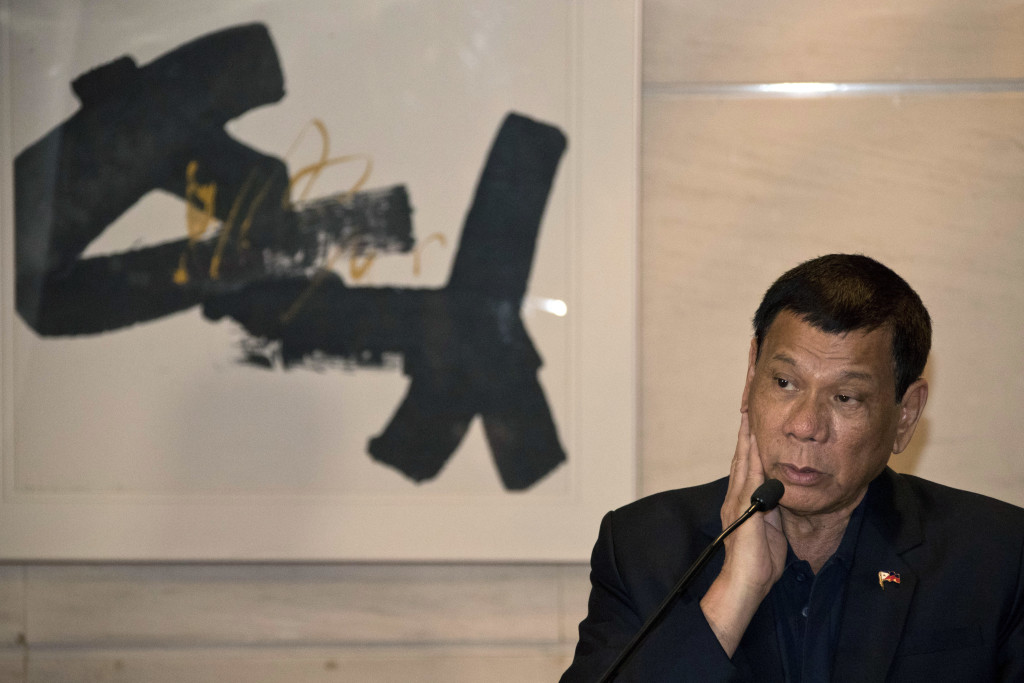
Philippine President Rodrigo Duterte speaks during a press conference in Beijing, China, Wednesday, Oct. 19, 2016. Duterte’s effusive message of friendship on his visit to Beijing this week has handed China a public relations bonanza just three months after Beijing suffered a humiliating defeat by an international tribunal. (AP Photo/Ng Han Guan)
President Rodrigo Duterte was “taking an enormous risk… by trying to throw overboard the Philippines’ best leverage against China, in case China decides to be coercive” in the Spratlys, where reefs and shoals are still being disputed by claimant-nations, including the Philippines, the head of a US think tank said on Friday.
“If President Duterte decides to seek to abrogate a US security treaty alliance with the US, then China no longer has to fear that it will provoke US intervention if it moves against the Sierra Madre,” Gregory Poling, director of the Asia Maritime Transparency Initiative (AMTI) told the Inquirer in an interview Friday.
Poling was referring to the BRP Sierra Madre, the Navy hospital that despite its decrepit appearance, which was marooned on the Ayungin Shoal to guard the Philippines’ rights over the Ayungin Shoal (Second Thomas Shoal). A small contingent of Philippine Marines is also stationed at the ship.
The US has been the only deterrent to China’s long drawn out effort to take over Ayungin Shoal, a resource-rich reef.
Ayungin Shoal is 105 nautical miles from the coast of Palawan, putting it well within the Philippines’ 200-mile exclusive economic zone under international law.
It has become the flashpoint in the maritime dispute between the Philippines and China.
On Thursday, Mr. Duterte declared at a state visit in Beijing that he was cutting military and economic ties with the US, surprising a nation and a people with deep and long ties with its Western ally. He did so even before he met with Chinese President Xi Jinping, sending his Cabinet men scrambling to contextualize and interpret what the President said.
READ: Duterte announces military, economic split with US
“I know we all want to believe that everything is going to work out and I think it is important to hold an olive branch to the Chinese… But we should do it with open eyes. We shouldn’t assume that all of a sudden, Beijing is going to change its behavior,” Poling said.
Poling emphasized that the Chinese have been “prevented” to take over Ayungin Shoal “not because they are such nice guys but because of the fear that while the US is neutral on territorial questions, it will move if there is violence used against Philippine troops.”
Poling said Article 5 of the Mutual Defense Treaty is “crystal clear.”
The treaty says that both the Philippines and the US recognize “that an armed attack in the West Pacific Area directed against the territories of either of the Parties would be dangerous to its own peace and safety and declares that it would act to meet the common danger in accordance with its constitutional processes.”
Poling said that President Duterte appeared to have bet “on a single plan” when it comes to trying to resolve the maritime dispute with China, and that is to bank on “Chinese goodwill.”
READ: Senators caution Duterte on implications of PH-US split
“It does not come with a Plan B by taking away the US military, which is the Philippines’ best leverage against China in case it decides to be coercive,” Poling said.
According to Poling, President Duterte cutting military ties with the US meant that he did not want America’s “security guarantees.”
“How is China going to interpret that? If it hasn’t changed the underlying claims it is just a matter of time before it decides it’s time to [make its] move [on Ayungin],” he said.
Poling said it was noteworthy that China has not let up on its reclamation efforts and installation of military strongholds in the Spratlys even after The Hague-based Permanent Court of Arbitration (PCA) handed the Philippines an overwhelming victory in its complaint against China over maritime rights.
China “has completed hangars base, three full regimens of 24 fighter jets at each of the three biggest islands it occupies including Mischief Reef. It is almost done,” Poling said, stressing that Mischief Reef (Panganiban Reef) is a mere 22 nautical miles from the Sierra Madre.
These military features, and many other more, are expected to be fully operational by next year.
“We’ll see the first deployments of the fighter jets before that. So how can you not be nervous when Subi Reef — within sight of Pagasa [Island]– is having a full complement of PLA [People’s Liberation Army] Air Force fighter jets,” Poling said.
The AMTI has been tracking China’s reclamation efforts in the Spratlys that began in 2013. Since then Beijing has “created 3,200 acres of new islands,” AMTI said.
China has reclaimed 976 acres of new land on Subi Reef (Zamora Reef), which is 14 nautical miles away from Pag-asa Island, where a small Filipino community lives.
It has reclaimed 1,379 acres of land on Mischief Reef.
It would be no guarantee even if Mr. Duterte becomes China’s best friend that the superpower seeking its place in the regional and global stage would recognize the Philippines’ sovereign rights in the disputed islands.
“I think that President Duterte has made the determination that he can cut a deal with China like fishing access to the Scarborough Shoal based upon an assumption of Chinese goodwill and the desire in Beijing to negotiate in good faith. But where that idea comes from I am not entirely sure,” Poling said.